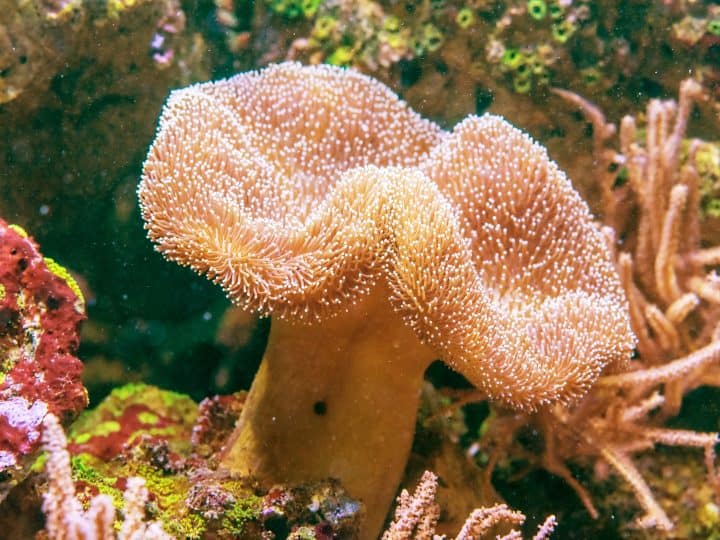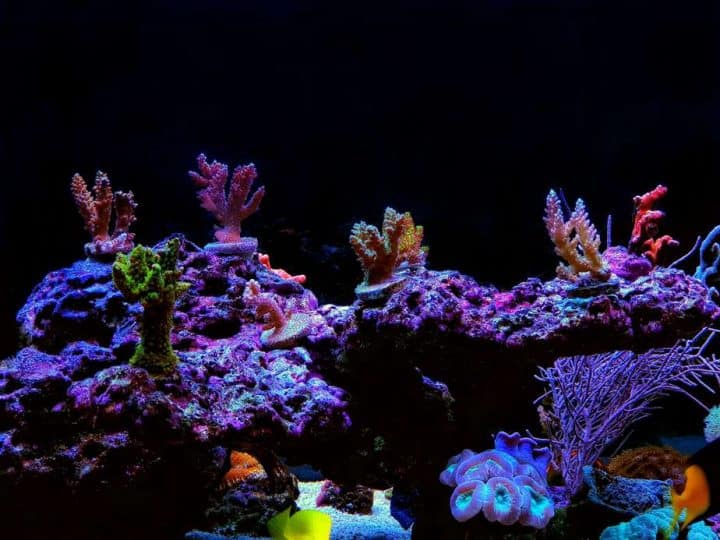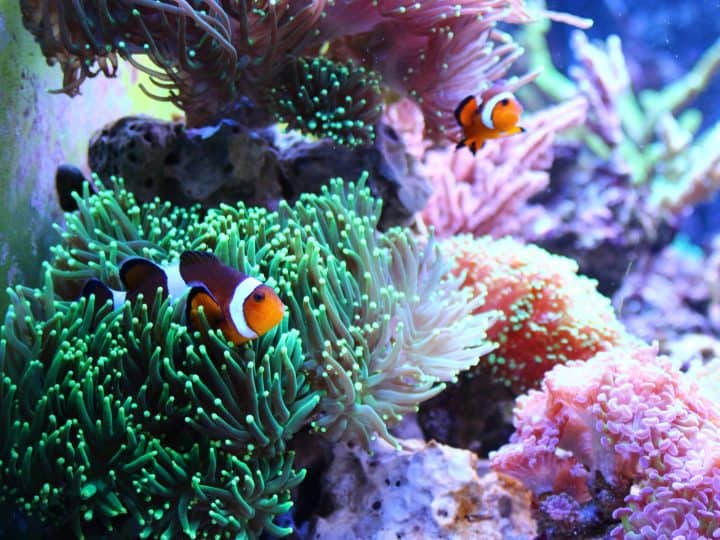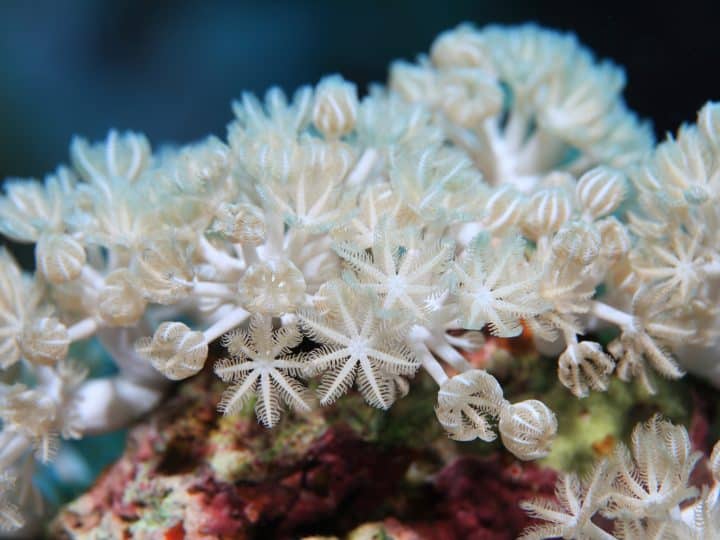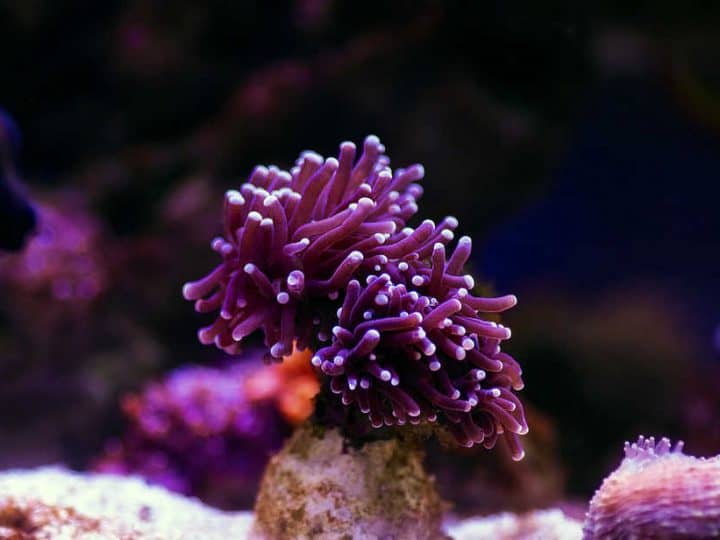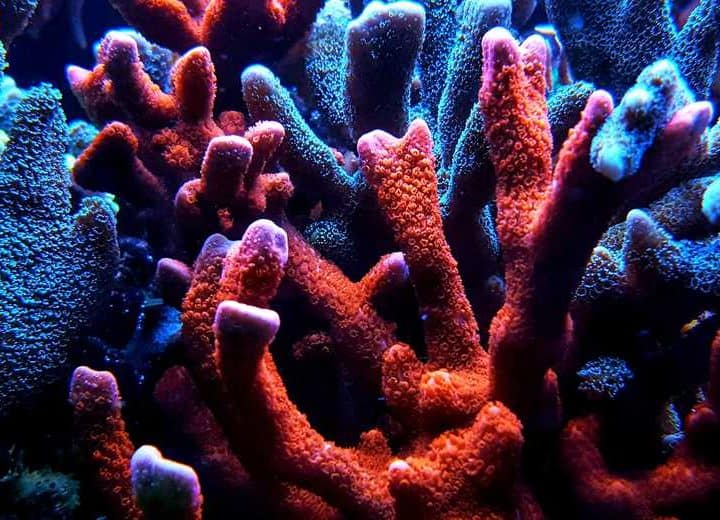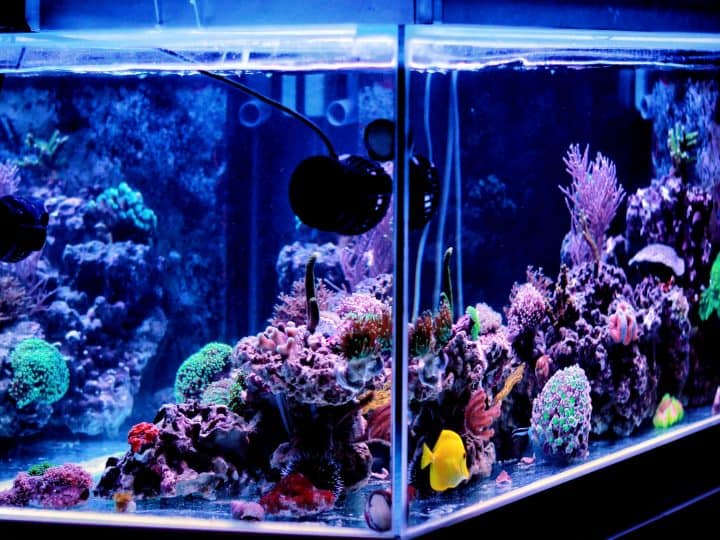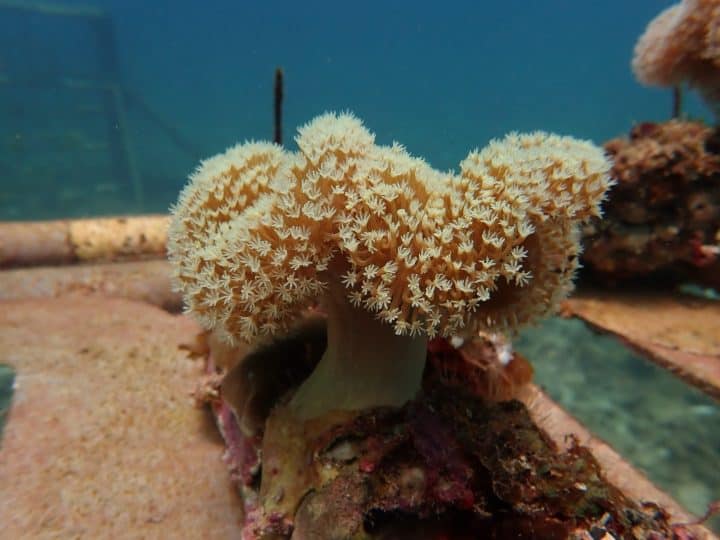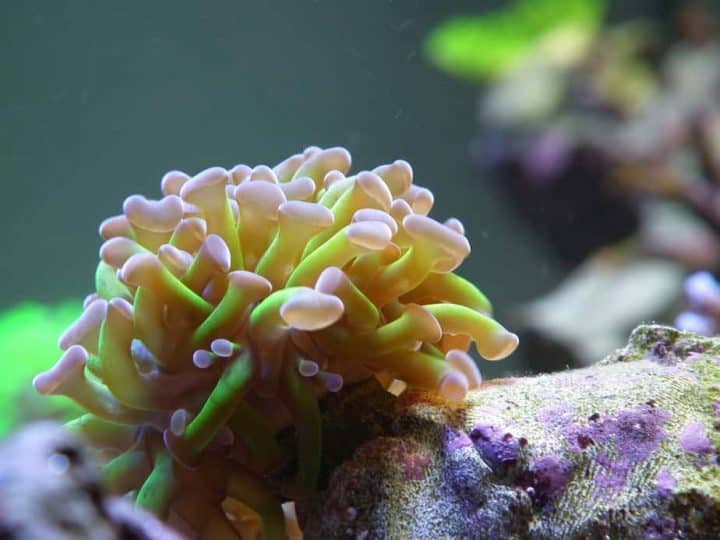As the craze for coral reef tanks is increasing day by day, the fact that’s constantly thwarting many people’s plans is the need for a big tank. Yes, a big tank will allow you to be more liberal in terms of maintenance. But there should be no reason you can’t grow a piece of the ocean in a small-sized aquarium.
You need to look for corals that are tough, least aggressive, and resilient to changes in water parameters. These are the hallmarks of corals that are suitable for nano tanks. Anthelia, Pulsing Xenia, Duncan corals, and zoanthids are some, to name a few.
But don’t jump to the conclusion already. The choice for coral species can vary from person to person as not everyone has the same mentality or taste. All of them look different and offer diverse aesthetics to your aquarium. This is why I have made a list of the 10 most beautiful corals for a nano reef tank to help you choose the right one. So, let’s begin.
Best Corals For Nano Reef Tanks
There are plenty of species of corals. But when it comes to tiny tanks like nano reef tanks the corals you choose need to be extra tough. Here are a list of 10 that I think would be best for anyone planning to decorate their nano reef tank.
1. Candy Cane Corals
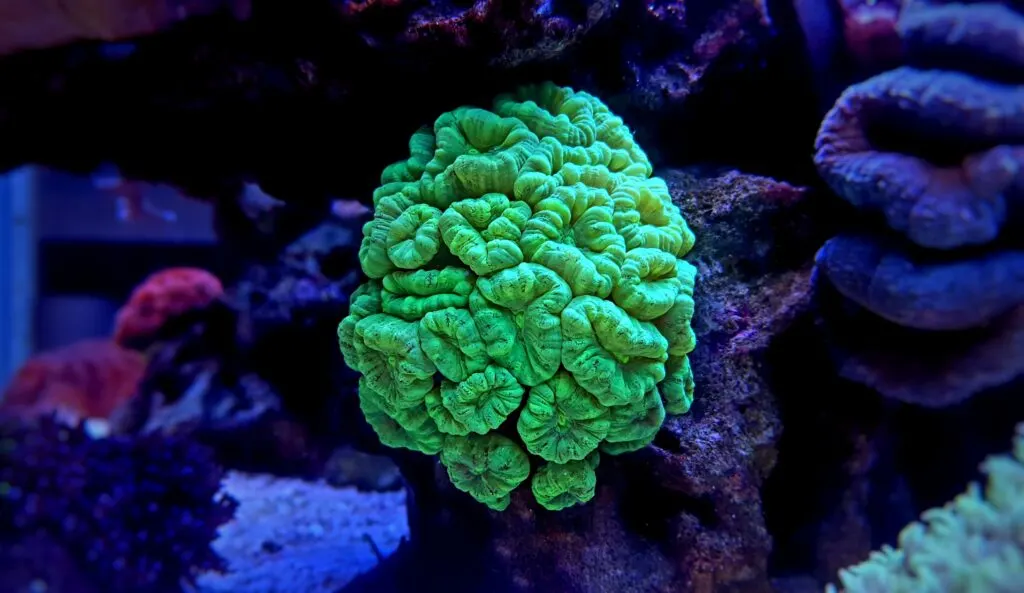
Candy cane corals are a member of large polyp stony or popularly known as LPS corals. They are very suitable for any saltwater aquarists who don’t want to spend a fortune on humongous tanks. It comes from the genus Caulastraea and is often termed as torch corals or trumpet corals. A colony of candy cane corals makes a branching appearance which is very pleasant to watch.
Other species of Caulastraea are something aggressive but candy cane hasn’t gone down that path. This coral has short tentacles and is very well-mannered to other inhabitants of the nano reef tank. It can catch small prey and do well with supplementary feeding. However, food supplement isn’t necessary as it can photosynthesis and be on its own.
Candy cane requires medium to low lighting and medium water flow. So, if your tank does not have proper lighting arranged, that should be the least of your concern. It’s better if you place it on the floor of the tank, sand substrates are preferable. If the room you are in is bright or has a direct light source, place it somewhere darker. Lighting deficit does not affect the coloration.
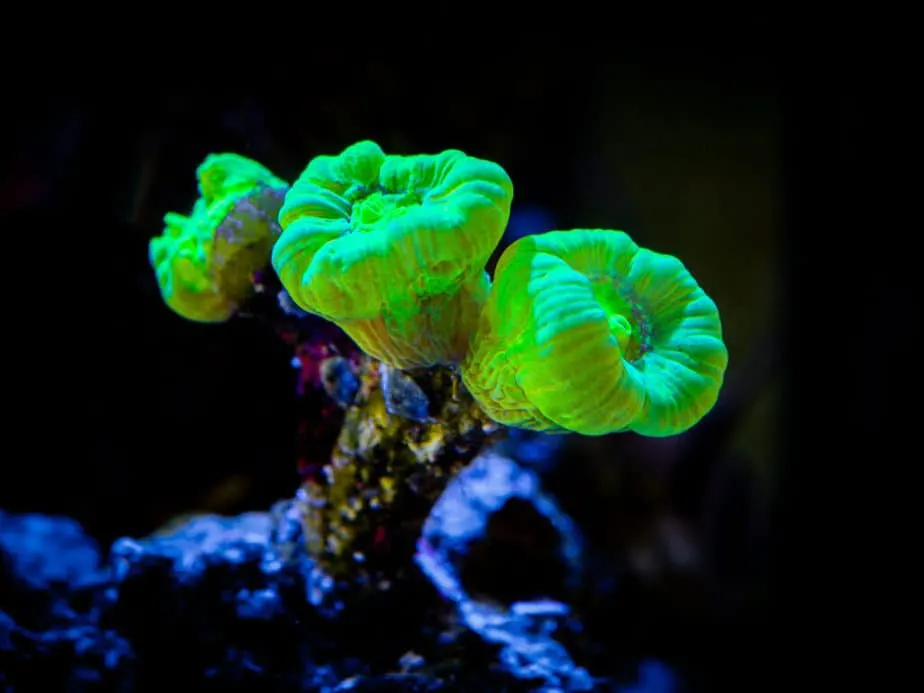
Candy cane coral is very hardy and does surprisingly well in varying water conditions. If you want the best outcome, emphasize supplementary feeding rather than water parameters. It yields better color if fed a few times every week. Try not to move them once placed. Check for red flags such as sudden whitening or shrinking, just in case.
2. Blastomussa Corals
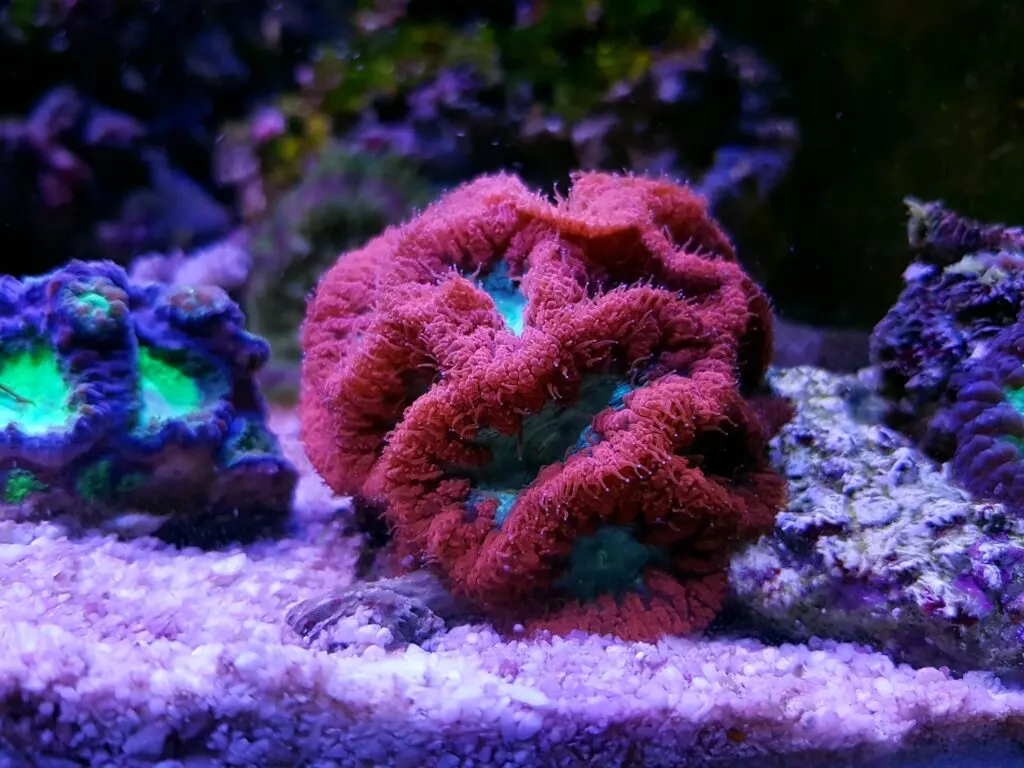
In my quest to find the best corals for nano saltwater aquariums, Blastomussa is the second one. It’s one of those very few LPS corals that are highly adaptive in nano reef tanks. It is also called Pineapple coral or just Blasto. Due to its swollen fleshy polyps, it resembles brain corals and is often mistakenly referred to as swollen brain coral.
Blastomussas are very meek and play well with others. They have tentacles to capture prey or clear any surrounding debris. But they are highly unlikely to attack other corals. Even if they do, their stings are not venomous at all. I rather recommend keeping them at a distance from other aggressive species because Blastomussa will probably be at the receiving end.
There are several species of the Blastomussa genus. Among them, Blastomussa Merletti and the Blastomussa Wellsi are the two most common. Blastomussa Merletti’s polyps are much smaller compared to the Wellsi. So, for nano tanks, my suggestion is to take the Blastomussa Merletti.
Blastomussas do reasonably well in Low water flow and mild lighting. They thrive in beginner level care and standard water conditions. They are impervious to major changes to water conditions which make Blastomussas are an excellent candidate for small reef setups. They have Zooxanthellae in their tissues so feeding isn’t much of a concern
3. Pulsating Xenia

It’s sounding like you’ve heard it before, right? That is because you have. It is very popular by its trade name, pulsing xenia. This spectacular species is a very unique coral. It is very hardy, peaceful, and low demanding. In fact, pulsing xenia is one of the least aggressive species you can have in your tank.
Pulsing xenia is a great beginner coral, which is also why it’s on my list of 15 great corals for beginner reefers. Make sure to check out the full list here.
It grows blazing fast. A very few corals beat them in case of fast growth. If you want a tank full of Xenias and nothing else, this is your take. Pulsing Xenia is well adapted to varying conditions and does fairly well in inclement waters. However, if you are growing SPS in your tanks, xenia coral is likely to suffer from a growth deficit.
This is because they do well in high nitrate-containing water whereas SPS corals cannot stand nitrate at all. This is necessarily not a bad thing if you want to keep the growth at bay since you have a small tank setup. If you are growing only Xenias in your tank, you can try tweaking the nitrate level to control the growth.
Pulsing Xenia isn’t very demanding. It flourishes moderate light and flow. As far as the water parameter is concerned, it can take anything you throw at it. All of this sums up to be the perfect coral species for your nano aquarium. If you want more sustainable species, look for aquacultured Xenias.
4. Zoanthids
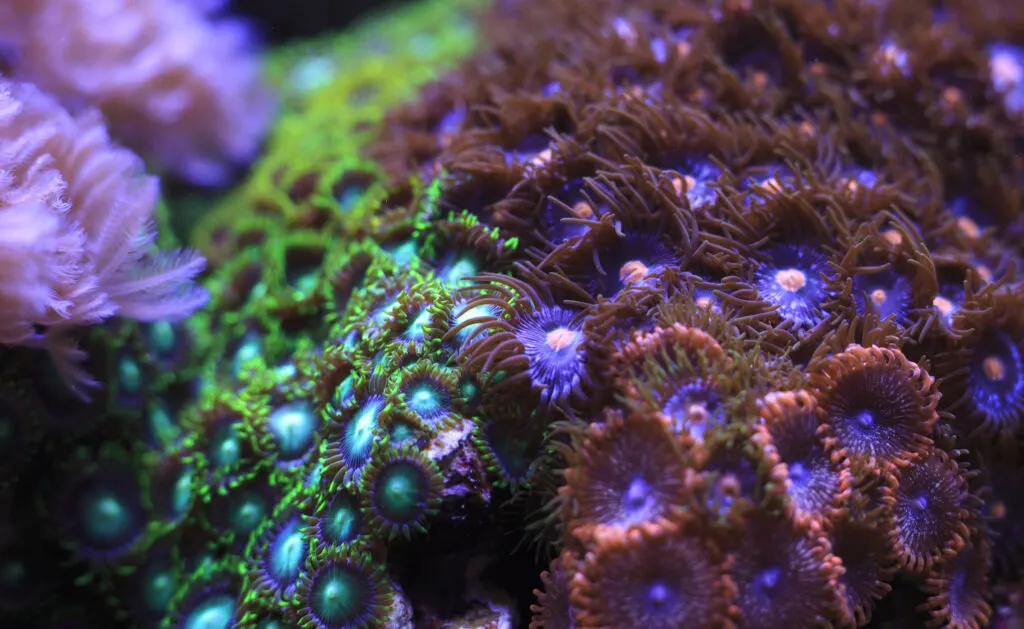
Zoanthids are extremely popular corals. The main reason behind this is their gorgeous look. They are very attractive and come in a variety of colors. They are photosynthetic but many species can catch prey. Periodic feeding is recommended depending on which species you have in your aquarium.
If you want to depend solely on photosynthesis, be sure to provide adequate lighting. As for water flow, the medium is preferred. If the flow is too high, they might have trouble opening their polyps. Place them anywhere in the tank where there is medium flow and a little bit of light is present. You won’t need a separate lighting arrangement for Zoas.
Standard water parameters are well enough for zoanthids. They are very hardy and do well in pretty much any water conditions. If you want the dazzling view which you paid for, keep the water flow low and specific gravity unaltered. Zoas are sensitive to these two conditions more than anything else.
Not that they will die or something if there is a swing in specific gravity or water current. Their polyps will face hardships to open and close properly. A slight tweaking shall fix the issue. Here’s a little hack; to keep everything perfect, make sure the salt you are using is of high quality. That will set everything right.
5. Anthelia Corals
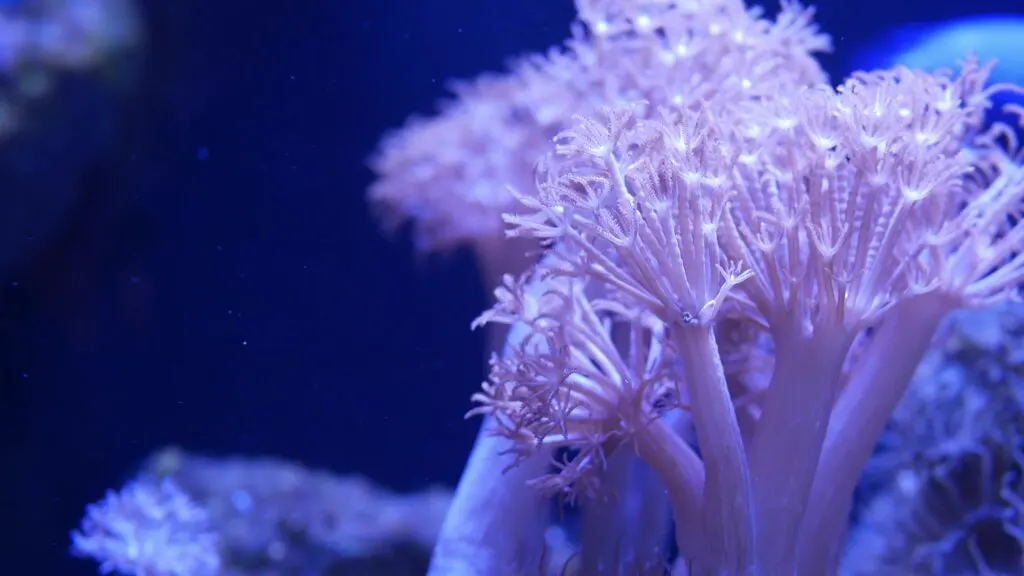
This genus of corals is also known as waving hand coral or pink waving hand coral. It is because they are pink and they wave hands. To some extent, Anthelias resemble pulsing xenia. At least their hand-like appearance shall remind you of Xenias. But Anthelias hands are bigger and most of the time they don’t exhibit the pulsing sway like Xenias.
You can keep Anthelias in any intensity of lighting, no matter low or high. They are very peaceful and go along with other coral in captivity. They are very easy to take care of and offer aesthetically pleasant views to any aquarium. These traits make Anthelias a very demanding coral for beginners and nano tank owners.
You can place them anywhere in the tank as long as there is medium water flow present. They grow fast regardless of water conditions as long as nothing drastic. Remember that colonies of Anthelias are very susceptible to neighboring fish, crab, or other creatures. So, place them at a distance.
Anthelias are photosynthetic and require nothing extraordinary in terms of feeding. They absorb organic particles shed by other captives in the tank so supplementary feeding isn’t mandatory. You can add zooplankton if you want rapid growth and spread.
6. Leather Corals
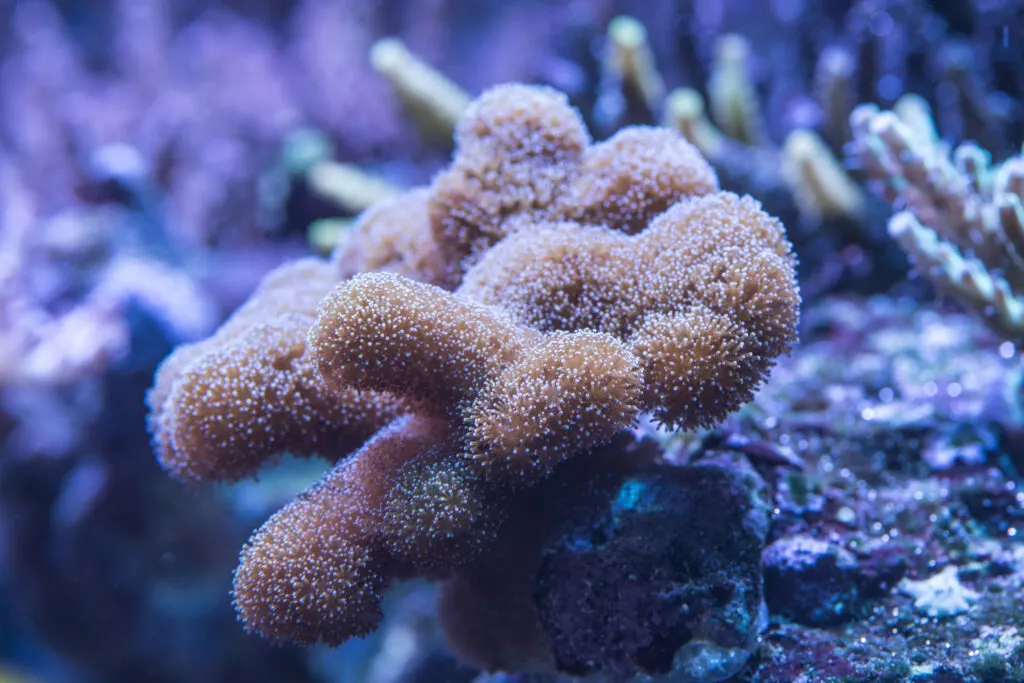
Sinularia genus is soft corals and has a leather-like feeling, hence the name leather corals. They have more than 150 species and come in numerous sizes, shapes, and colors. Leather corals are very popular and widely available in the market. This is why they are selected by many avid aquarists as their starting coral.
Like other soft corals, leather corals are tolerant of diverse water parameters. This is possible due to the absence of a calcified skeletal structure. Skeletons are made of calcium and are heavily influenced by water calcium levels. Lack of skeleton allows it to survive in adverse conditions that might occur in nano reef aquariums.
For beginners, leather corals are very easy to take care of. Once you’ve set up your tank properly with a specific parameter, that’s it. Moderate lighting and flow are sufficient. When placing, make sure there is enough space surrounding the coral as they tend to spread after growing. Leather corals do not need feeding. They accumulate necessary nutrients from the water.
Leather corals often develop a wax-like coating on them. This is normal. During this time the coral may act timid and keep their polyps retracted. No need to worry as it is a physiological phenomenon. The coating will shed after a few days.
7. Sun Corals
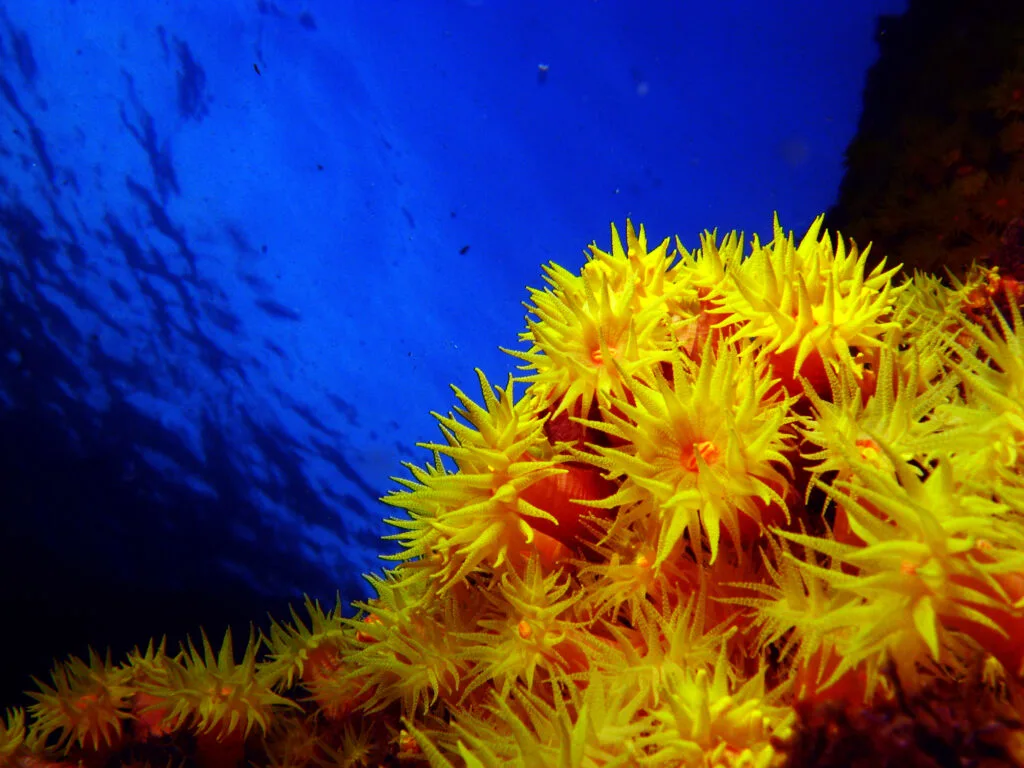
Sun coral comes from the genus Tubastraea, is a very dazzling looking coral that is sure to attract any aquarists. It is named so because their polyps resemble the sun thanks to their round shape, fleshy appearance, and bright yellowish-orange color. They slightly look like sunflowers, just a bit bulkier.
They are non-photosynthetic which kind of cuts both ways. How is that you might wonder? They need regular feeding but you can place them anywhere in the tank no matter the lighting. Place them in shaded areas but make sure you can easily feed them. They happily accept rotifer, Mysis shrimp, or any other kinds of seafood. Remember to chop the foods up beforehand.
Sun corals are non-aggressive. You can place them with other animals. If you place them directly on the sand, make sure you don’t have any fish like gobies in your aquarium. They might bury your corals alive under the sand. Water parameters shouldn’t be a headache for sun corals. They do very well in any condition.
When feeding sun corals, remember that they prefer their food in the dark. So, make sure the room is dark whether it’s day or night. As for frequency, feeding them 2 or 3 times every week is enough for their growth.
8. GSP Corals
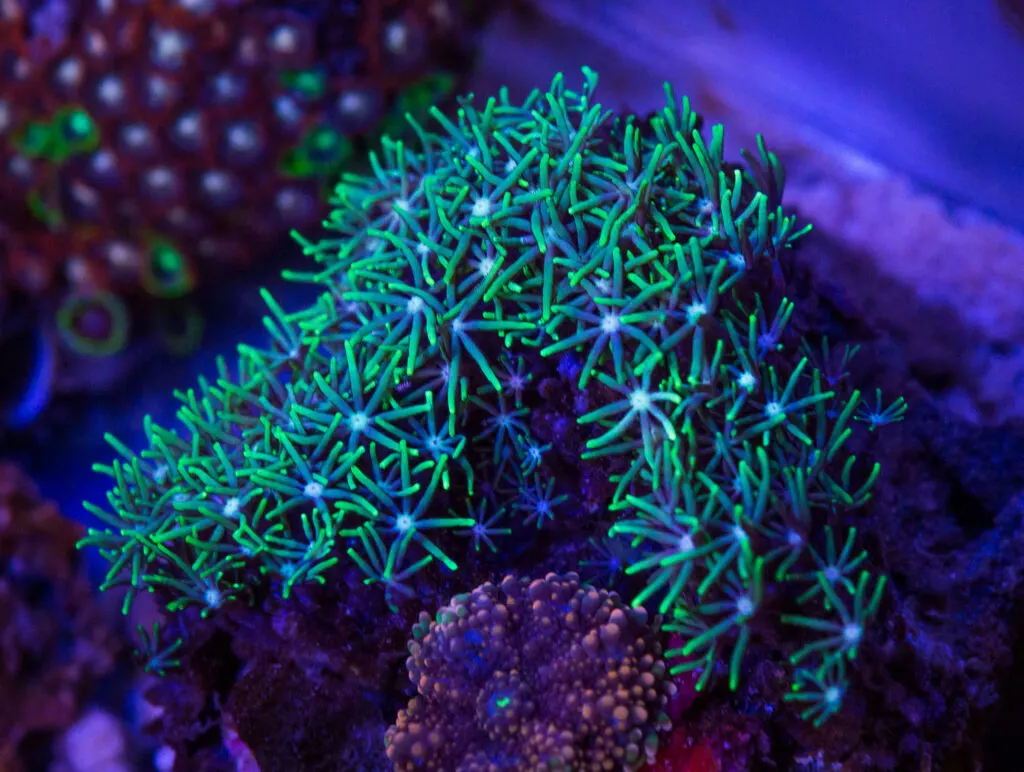
Green star polyp corals or GSP’s are widely chosen for a variety of reasons. They are hardy, tolerant, and grow fast. They are available in different vivid colors like metallic green, brown, dark green, etc. They are peaceful and don’t fight with other corals. However, they tend to overwhelm any sessile animals so watch out for that.
You don’t need to worry much about their placement. As long as there is medium flow and light available, you can place them anywhere in the tank. Make sure you use high-quality salt when making the saltwater because green star polyps absorb necessary nutrients from the water column.
They also make their food by photosynthesis and take small shrimp or crabs as supplemental foods. Although that is not mandatory, additional nutrition means good growth. A standard water parameter is recommended for optimal growth. Note that green star polyps mostly depend on photosynthesis. So, make sure that the light is never too low.
As they grow very fast, you might want to trim them regularly to keep them at bay. A special type of coral trimmer is available in the market, check your local fish store. If you want to strictly control their growth, you can take measures like restriction, termination, etc.
9. Duncan Corals
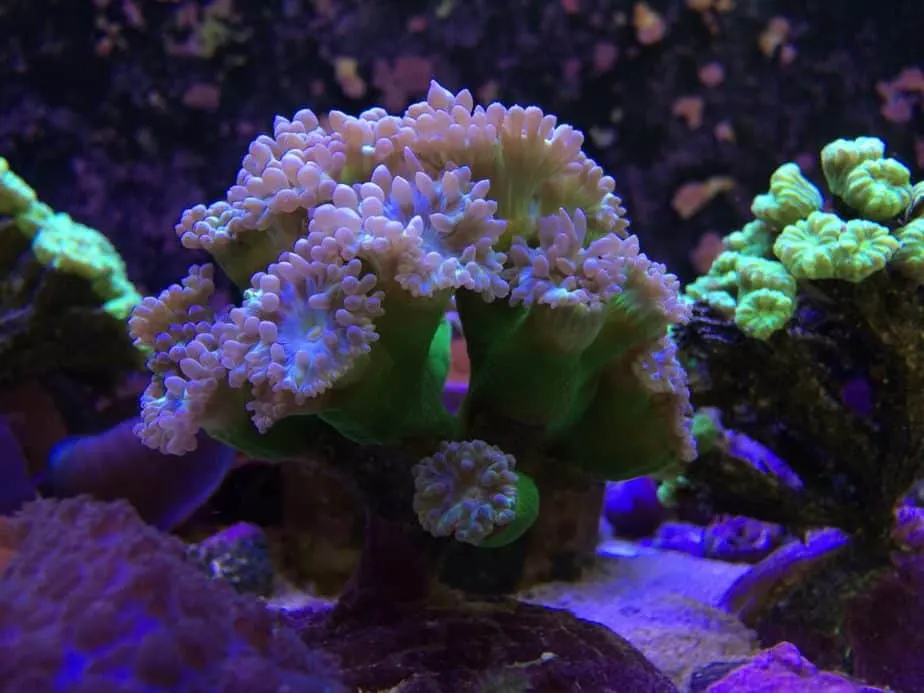
They are another type of LPS corals that are suitable for nano reef setups. They have a disk-shaped body and short tentacles extending from the periphery of the disk. Duncan corals are also known as branched disk coral or whisker coral. They are peaceful and do not have any defense mechanism at their disposal. So, do not out them with aggressive tankmates.
They prefer mild water flow so it is better to place them at the bottom of the tank. They grow rapidly and can easily spread in your tank. This is the reason Duncan corals are not preferred by many for their nano tanks. But if you can control their growth, Duncan corals can be one of your top choices.
They are benefitted from the symbiotic relation with zooxanthellae algae so doesn’t necessarily require separate feeding. However, like any other corals, who doesn’t like free food? You can feed them chopped up shellfish, shrimps, cyclops, etc. Do not move them once placed as their body might get shredded. Also, excess light can make the algae overgrow, hampering the symbiotic relationship.
10. Mushroom Corals
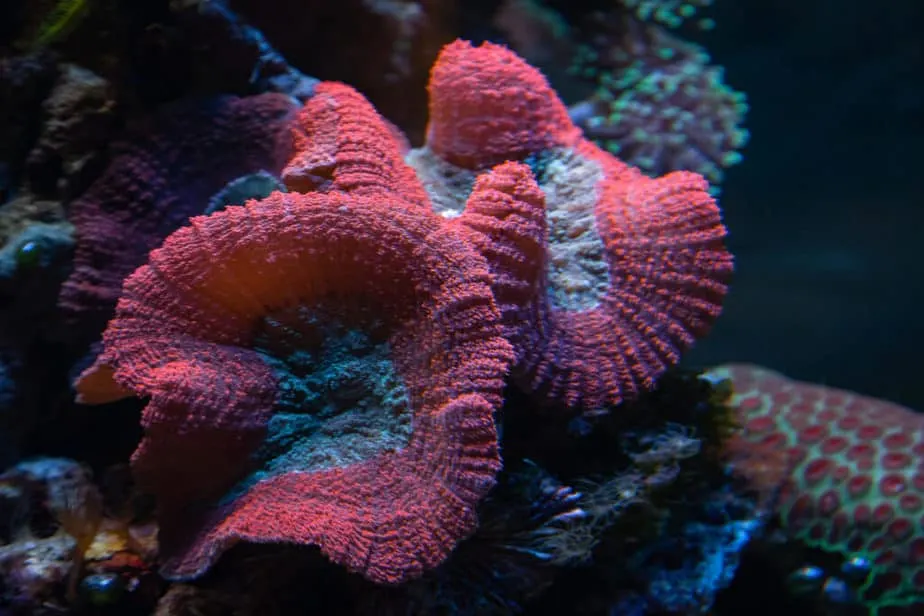
Mushroom corals are highly popular and chosen widely by beginner and expert aquarists, both for large and nano tank setups. They are photosynthetic, don’t require anything exorbitant in terms of water conditions, and do well in low lights. All of these attributes make them a worthy selection in this list.
They are also called bounce corals, mushroom anemones, false corals, etc. Mushroom corals lack many characteristics of corals; hence they are often referred to as false corals. They are found in shallow and often polluted waters. That’s why mushroom corals can withstand differing water conditions.
They do not have very intense lighting. Just mimicking their natural habitat’s lighting is enough, which is medium to dark. The lighting just needs to be enough for photosynthesis. Also, there are some species that require intense lighting. If you don’t get the lighting exactly accurate, their growth won’t hamper. They’re hardy enough and that’s what granted them a place in this list.
Like lighting requirements, they also possess varying growth rates. Some species grow fast while some are slow. If you want fast growth, try looking for Discosma mushrooms. They grow reasonably fast and will soothe your desire for a tank full of corals. For beginners, knowing the right species can be perplexing. I suggest you consult a coral expert in your vicinity.
Conclusion
When it comes to choosing corals for your nano reef tank, there are a lot of factors like the hardiness, colony size, aggression of the coral species that come into consideration. You should also consider the appearance of the coral species that will look natural in your miniature reef system. Like anything else, keeping Corals requires dedication.
When picking a coral species, the choice is yours. There are hundreds of coral species available out there, each with its own perks. And each coral species that I have mentioned in this article is worthy to be on the list of the 10 most beautiful corals for a nano reef tank. Thank you for having the patience to go through the entire article. Have a great day!

